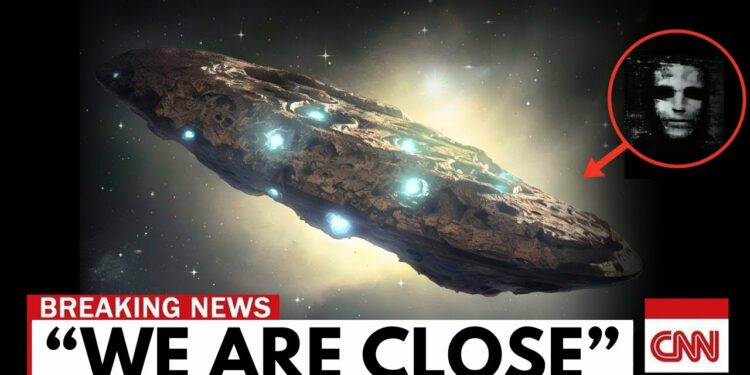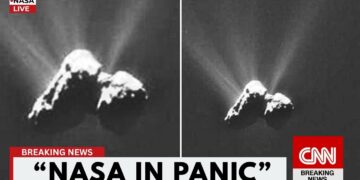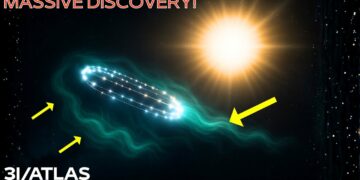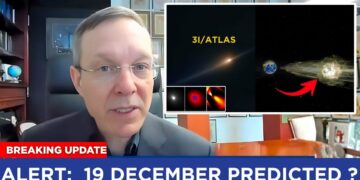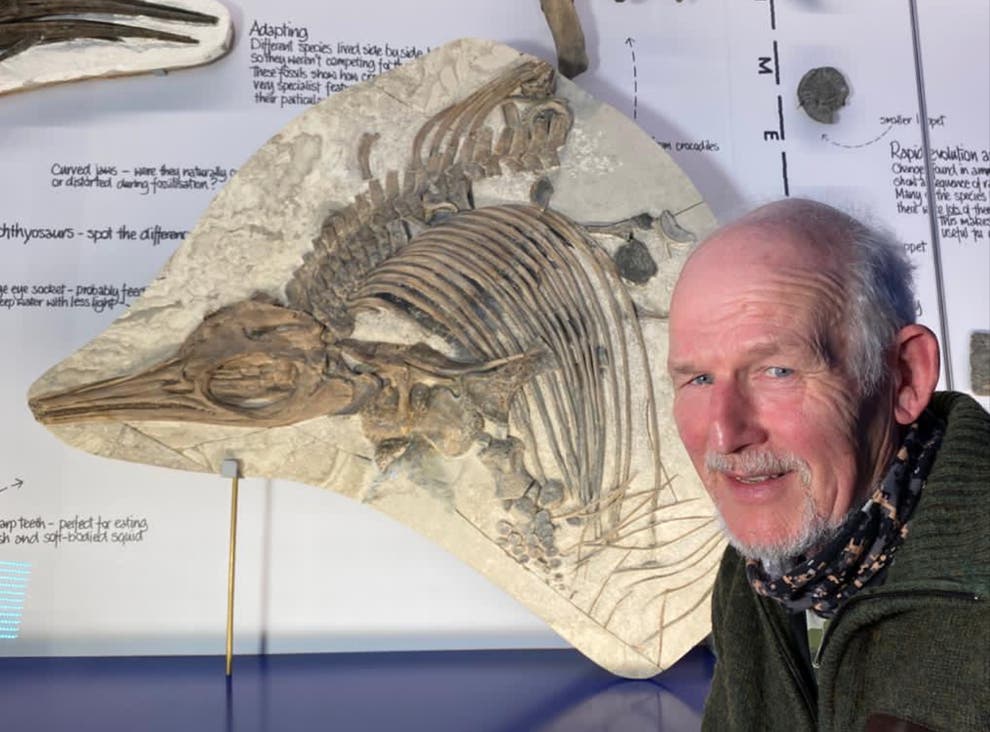There are moments in history when the universe seems to whisper a warning, and this might be one of them. The James Webb Space Telescope has achieved something extraordinary, capturing the first clear image of an object that could reshape our understanding of our place in the cosmos. Officially cataloged as Three Eye Atlas, it’s classified as an interstellar comet. But what if it’s not a comet at all? What if it’s a vessel—an alien craft disguised in ice and dust, silently traversing our solar system with unknown intentions? Decades ago, Stephen Hawking cautioned, “Don’t send signals into space, because if someone hears us, they might come.” We didn’t heed his warning. For over a century, Earth has been broadcasting its presence into the void, and now something has arrived.
What the James Webb observed is not merely unusual—it may be the clearest indication yet that we’ve been discovered. And whoever found us has been planning this moment for a very long time. When astronomers first detected Three Eye Atlas, it was dismissed as just another comet, a benign wanderer from interstellar space. However, the James Webb’s precise imaging revealed anomalies. The object’s structure and surrounding dust cloud didn’t align with typical comet behavior. Its trajectory was remarkably precise, perfectly aligned with the orbital plane of the planets—a rarity in nature. Then came the startling revelation: its speed. Traveling at 255,000 km/h, faster than any known comet of its size, it could cross the United States in under two minutes. Yet, it wasn’t just moving quickly—it was moving intelligently. Its path included close flybys of Venus, Mars, and Jupiter, using their gravity as slingshots, a maneuver that requires years of planning for human space missions. The odds of this occurring naturally? About 1 in 20,000.
Harvard astrophysicist Avi Loeb and his team began to suspect that Three Eye Atlas wasn’t just an interstellar rock—it was something designed. Adding to the unease is its timing. Its closest approach to the sun, its perihelion, will occur when Earth is on the opposite side of the star. For several weeks in late October 2025, it will be invisible, hidden in the sun’s glare. No telescopes, no radar, no tracking. In space, this is the perfect window for something under intelligent control to act. During those unobservable days, a hidden propulsion system could activate, altering its course with precision, undetected. By the time it reappears, it could be on a new trajectory, and we’d only realize it too late. Such a maneuver would be impossible for a natural object but trivial for an advanced probe disguised as a comet. Loeb’s team suggests this timing isn’t random—it’s an opportunity, possibly intentional.
If you wanted to send a probe across the galaxy unnoticed, what better disguise than a comet? A solid core cloaked in ice and dust, venting gas near the sun to create a blinding halo that obscures its interior. Telescopes can’t penetrate it, and radar is scattered by its irregular surface. Any heat from onboard systems would blend into the chaotic outgassing. It’s nature’s stealth technology, easily replicated by an advanced civilization. NASA has studied ice shielding for deep space missions, not only for protection against radiation and micrometeoroids but also for long-term survival in interstellar space. For a civilization millions or billions of years ahead of us, crafting a comet-cloaked probe would be simple. The chilling possibility is that Three Eye Atlas has been hiding in plain sight, just another traveler—until now.
If artificial, what is its purpose? Loeb proposes two scenarios: friendly or hostile. It could be an explorer, a robotic scout mapping our solar system and sending data back to its origin. But history offers a darker analogy—the Trojan horse. When advanced civilizations encounter less advanced ones, the outcome is rarely favorable for the latter. If Three Eye Atlas is armed, the consequences are dire. A 12-meter-wide object striking Earth at its current speed would release energy millions of times greater than the most powerful nuclear bomb, triggering global firestorms, blocking the sun for years, and potentially ending human civilization. NASA is rumored to have a contingency plan, “Shield 3,” to intercept Three Eye Atlas if needed. But its speed makes interception challenging, requiring an early launch far from Earth.
The James Webb’s initial image sparked global intrigue, but its follow-up spectral data was even more unsettling. By analyzing the object’s light, the telescope detected traces of metals and compounds unlike any known comet, with reflective patterns resembling engineered alloys, not natural rock. Faint, consistent heat anomalies within its icy shell suggested an internal power source, too stable to be caused by sunlight alone. For Loeb and his team, this was a near-fingerprint of artificial origin.
Stephen Hawking’s warning was once theoretical, but Three Eye Atlas makes it feel real. In the “dark forest” model of the universe, civilizations stay silent to avoid attracting advanced, potentially dangerous entities. Earth has been loud, with a century of radio, TV, and intentional interstellar signals acting like a flare in the night. If Three Eye Atlas is a probe, it may not be here by chance—it could be here because we called it. This shifts the mystery: not just whether it’s alien, but whether its journey began when we first revealed ourselves.
At NASA and the Department of Defense, rumors of a classified “Shield 3” rapid-response spacecraft program are growing. The plan involves a high-speed interceptor to match Three Eye Atlas’s trajectory, but no existing rocket can achieve the necessary speed in time. Engineers are reportedly exploring nuclear thermal systems, solar sails, and experimental ion drives, but funding and feasibility remain uncertain. An unspoken deadline looms: if Three Eye Atlas emerges from the sun’s shadow on a course toward Earth, Shield 3 may become humanity’s only defense.
As its solar conjunction approaches, observatories worldwide are focusing on Three Eye Atlas. The James Webb, positioned beyond Earth’s atmosphere, detects faint fluctuations in light, shifts in spectral composition, and rhythmic dust emissions that some interpret as possible encoded signals or system activity. Others dismiss these as natural variations, but the possibility lingers. Once it vanishes behind the sun, the next sighting could reveal a changed trajectory or purpose. This brief window may be our last chance to understand what we’re facing or prepare for what’s coming. Increasingly, it feels less like we’re observing it and more like it’s observing us.
When Three Eye Atlas emerges from the sun’s glare, the world will be watching. If it follows its predicted path, it may fade into obscurity, a mystery we’ll never fully unravel. But if its course has shifted, we’ll know someone—or something—has been steering it. The James Webb has shown us its appearance; the question is its intent. Is it a curious machine, drifting between stars, or the first step in a plan conceived long before we knew the stars were watching? In the vast silence of space, a small change in direction could be the loudest message ever sent. Are we ready for what comes next?

